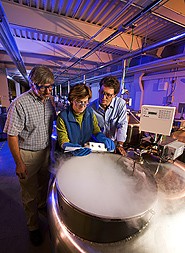|
Read the
magazine
story to find out more. |
|

At the ARS
germplasm preservation facility in Fort Collins, Colorado, plant physiologists
Dave Ellis (left) and Christina Walters and visiting Brazilian geneticist
Luciano Nass remove pepper seeds from long-term storage in liquid nitrogen.
Nass is working at the ARS facility as part of the Labex exchange program.
Click the image for more information about it.
|
|

|
U.S. and Brazil Sow Seeds for Germplasm
Exchange
By Laura
McGinnis February 5, 2007
A collaborative effort between U.S. and Brazilian scientists is
setting the stage for significant international exchange of germplasm—the
material plants and animals use to reproduce.
The U.S. Department of
Agriculture's chief scientific research agency, the Agricultural Research
Service (ARS), is helping its Brazilian
counterpart develop a new animal genome database. This effort is part of an
ongoing collaboration between the two countries, called "Labex," through which
the United States and Brazil share agricultural equipment, scientists and
expertise.
This is the first Labex effort to deal with genetic resources. As part
of the project, Brazilian visiting scientists Arthur Mariante and Luciano Nass
worked with ARS scientists at the National Center for Genetic Resources
Preservation (NCGRP)
in Fort Collins, Colo. They collaborated with ARS scientists on their research,
analyzed germplasm storage techniques and compared genebank management
practices.
Program leaders have also arranged for a Brazilian computer programmer
to work with U.S. programmers in Beltsville, Md., to develop a new version of
the animal germplasm component of the ARS
Genetic Resources Information Network.
Once the database is completed, people from both countries will be
able to query it to obtain information on the breeds and individual animals
whose germplasm is contained in the nations' repositories. In the future, this
information could facilitate the international exchange of germplasm or tissues
for genomic studies.
Read more
about the research in the February 2007 issue of Agricultural Research
magazine.